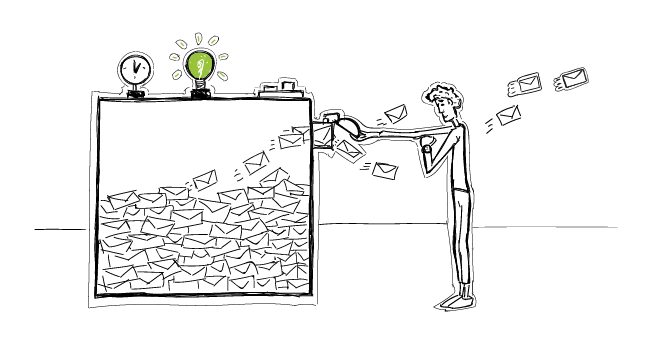Warming up the domain is a necessary step you need to take before kicking off your first cold email campaign. You can’t speed up the process, nor shorten it. But in the meantime, you can take care of your brand, figure out your campaign objective, build a prospect database, and draft your follow-up sequence to have it all set before your domain is ready for outreach.
#1 Warm up your email address
The email address, just like the domain, needs a bit of a warm-up before using it for outbound outreach full time. Bear in mind that you need a separate email address dedicated solely to outbound. This way you will keep your main email address safe from getting blocked.
So how does the process of warming up an email address looks like? Actually, quite similar to the domain warm-up. Start with sending a few emails per day to people you know, colleagues from work or friends, and ask them to reply to you. Then reply back. Make it look like a casual conversation. The point is to “show” the spam filters that you’re not a spammer who blasts hundreds of random emails to random people who neither open them, nor reply.
Read more about warming up an email address for outbound here:
How to Warm Up My Email Address before Cold Outreach? >>
#2 Polish up your website
Your website is probably the first place your potential customers stumble across while looking for more information about your company. Therefore, it should contain all the necessary information concerning your business and the product or service you’re selling.
Treat your website like an online business card. Don’t clutter it with irrelevant or outdated information. Make sure the visitors will be able to easily find what they’re looking for, for example, your company contact information, product description, or pricing. Don’t forget about maintaining positive user experience: make your website simple to navigate, fast-loading and responsive.
Audit your website to see if there’s anything that could be improved or updated. Check if your branding is coherent. Remember that the devil is in the details. Even the smallest things have a significant impact on the visitors’ first impression of your website.
#3 Take care of your social media profiles
Well-kept social media profiles increase trust in your brand and make your company look reliable in the eyes of the prospects. They are also a powerful marketing tool as well as an important communication channel to connect with customers.
But it seems that a lot of companies set up their profiles on every possible social media and don’t have the time to maintain them on a regular basis. As a result, there are many ghost social media profiles out there that give quite a bad impression of the companies they belong to.
Make sure you’re not one of them before you start your outbound outreach. First, decide which social media profiles are worth your time and effort to be maintained. Perhaps some of them are not really used by your target audience? Don’t hesitate to delete those which generate very insignificant traffic.
Then, make an audit of the other ones. Update the profile and background pictures, if necessary, or refresh your company description. Also, take care of regular posting, so your profile looks alive and kicking.
#4 Prepare your campaign objective
Let’s focus on your campaign now. Have you worked out your strategy yet? There are a couple of things to think over before you sit down to building your prospect database and drafting emails. Consider the following:
- Who’s the target group?
- What is the aim of this campaign?
- What are your business goals in terms of cold email outreach?
In order to target the right people, you should have your ICP defined first. This will help you narrow down your prospect search. Then, specify what you want to achieve with this particular campaign. Do you want people to have a meeting with you? Or to visit a dedicated landing page? Your prospects should have no doubts about what you want them to do. Next, think about the role of cold email outreach for your business. Set your KPIs and specify the expectations.
#5 Build your prospect list
Once you have your campaign objective thought out, you can start building a prospect list. We don’t recommend buying a ready-made prospect list. You risk that the database is outdated or badly targeted. Sending emails to invalid email addresses may affect your deliverability and result in burning your domain.
It’s best to build your prospect list from scratch by yourself. LinkedIn is the most popular platform for prospecting these days. It’s a true gold mine of B2B contacts. But there are more places worth checking, like Quora or AngelList. Here’s our list of 15 places to find B2B lists other than Linkedin >>
There are also prospect list building tools that will speed up the process and make it easier for you to collect email addresses and other contact information you may need. We review some of them to help you pick the one that suits your needs best. Make sure to check the following list regularly because we update it with new tools every now and then: 31 Tools & Services for Outbound Prospect List Building.
While you work on building the prospect list, it’s good to gather some more information about these individuals that you can use for personalizing your cold email copy. These can be some interesting facts, things you two have in common or something you particularly like about their business – in other words, the ice-breakers.
We call such bits of information snippets. Not only do they add a personal touch to each message, but they also differentiate the content of the emails within your campaign, which positively impacts your deliverability rate.
#6 Write and spam-check your email copy
Thanks to the insight you got while researching the prospects you can now prepare email copy that is tailored to your target group. You also gathered some information that can be used as snippets to make the emails feel more personal and break the ice.
The focal point of your email should be the prospect and their company. Don’t talk about yourself. Be empathetic. And don’t try to sell right away. Show the prospects that you understand their business niche and the challenges they face in their daily work.
Then, explain how your product or service can make their work more effective and easier. Make sure you clearly stated the CTA and a prospect will know what you want from them, be it scheduling a call, signing up for a demo or entering a landing page.
Don’t forget about scheduling 2 or 3 follow-ups. Use them to add additional value and grow your prospect’s interest. Avoid the reminder type follow-up emails. Nobody likes being nudged or rushed to do something, especially by a stranger.
To make sure your email copy is free of spam words, test it with mail-tester. The tool will analyze your message and check your mail server settings, so you will see if the copy requires some editing or whether you set up the technical settings correctly. Worth doing before you run a cold email campaign!
Also, come up with an enticing subject line to catch your prospect’s eye while they browse their inbox. Although we shouldn’t judge a book by its cover, busy prospects often ignore emails from strangers without even opening them. One way to spark their curiosity is to make the subject line address their business needs as explained in this blog post:
We’ve Examined Best Subject Lines, Here’s What We Discovered >>
#7 Don’t forget to set up your email signature
In outbound outreach, a signature plays the role of a business card. It should tell a prospect who you are and what you do, so you don’t have to start your cold email from introducing yourself and taking the main focus from a prospect.
Here are some best practices to create an effective sales email signature:
Best Signatures for Sales Emails: Let’s Analyze What Makes Them Effective >>
#8 Figure out the optimal sending time
Keep in mind that your prospects are busy people. They tend to check their inbox probably only a few times a day. Quite often they are also snowed under the emails and may miss your message if it’s buried under hundreds of others. That’s why it’s worth to choose the optimal sending time in order to increase the chance that your email reaches their inbox at the right moment.
There are no rules as to what day or time is best for sending cold emails. This is something you need to find out and test by yourself. It much depends on your target group and their working habits. You can do a bit of research and see how their typical day at work looks like. What time do they start? When do they typically check their mailbox? What is their lunchtime? Do they check emails on Sunday evenings?
Finding the answers to these questions will help you figure out the approximate time slots when your prospects are likely to read and respond to their correspondence. You can also discover the most optimal time by trial and error. A/B test different days of the week and time slots to find out when your open rate is the highest.
And finally…
Once your domain is all warmed up and you ticked off all the things from the above list, you’re well-prepared and ready to kick off with your outbound outreach. Fingers crossed!
READ ALSO

How to Build a Quality Prospect Base for Outbound: 5-Step Tutorial
In 2016, I wrote around 20 posts about prospecting tools and tactics. I decided to prepare a little synthesis of the prospecting know-how I've shared with you so far. Here's the outbound prospecting process divided into 5 steps.

What’s the Best Time to Send Email Campaign: Vol. 1 Stats
Time matters. Sending emails on particular days of the week and at specific times of the day may influence the open rates and response rates. That’s what has been proven by many studies. However, a major part of the research considers the best delivery time for email newsletters. Newsletters and cold emails are not the same, so can we apply those newsletter studies to cold emails as well? What is the best time to send email campaign?

How Should I Take Care of My Brand Online Before Email Outreach?
Most cold email senders craft their campaigns with a view to acquiring new business relations. They commit all their efforts to planning a new cold email campaign. They spend a long time on precise targeting, perfecting their email copy and taking care of impeccable deliverability. In the end, they do indeed achieve a very high open rate of their email campaign, one that would amaze even a well-seasoned cold email sender. Yet the reply rate to their campaigns is very poor. How is that possible?

